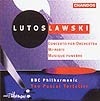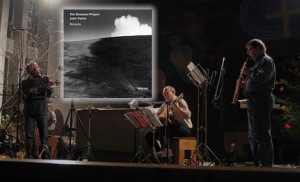Went to a great concert yesterday with Tim and Ann, who are visiting for the weekend. Unusually, we sat on the Town Hall stage and watched the orchestra that was on the ground at the back of the hall, I guess because the BBC Philharmonic at fairly full strength was too big for the stage. They started with Vltava from Smetana's Ma Vlast, and I was reminded what a beautiful piece it is, even with its false ending. It was also great to be hearing it live; the depth of the double bass and the sparkle of the percussion add something that I don't remember just with recordings.
The challenge of the evening was Lutosławski's Concerto for Orchestra, completed in 1954. Tim and Ann really like it, but on my first hearing I wasn't grabbed. Too often the percussion, for example, seemed to be playing completely incidentally to the rest of the orchestra. However, as a percussionist, at least there was an impressive range of percussion, including 4 different cymbals, 2 tenor drums, 2 side drums, gong and celeste. I must listen to it again -- and it was recorded for BBC Radio 3, but I can't find out when it will be broadcast. Alternatively the Phil have recorded it.The second half started with a very robust rendering of Grieg's Piano Concerto with soloist Aleksandar Madžar. Fantastic - with lots of great tunes that the Lutoslawski seemed to lack. The evening closed with Kodály's Dances of Galanta, which was quite enjoyable, and raised a smile with its unexpected final few beats.
Second up we tried our luck with The Dowland Project - an intriguing mix of 15th - 17th Century tunes with tenor, lute, viola and, err, sax. The Dowland refers to composer John Dowland, but they only did a few of his tunes, with music from all around Europe. One review of their most recent album Romaria says
Romaria is an ethereal listening experience. Its bold improvisatory elements make this recording well suited for the jazz enthusiast who is looking for a little something different.
John Surman's sax clearly lift it beyond just an 'early music' ensemble, and I thought his use of bass clarinet was inspired. He pushed into its higher registers, where it sounds quite sax-like, plus using it down low where it adds a funky woody vibe. It didn't quite attract me like the Hilliard Ensemble + Jan Garbarek combination does, but it was great to see them live, because they were quite clearly enjoying themselves as they played. And that's something you can hardly ever tell on a recording (except one Nina Simone track where one of the players at the end says "that's groovy, baby").


